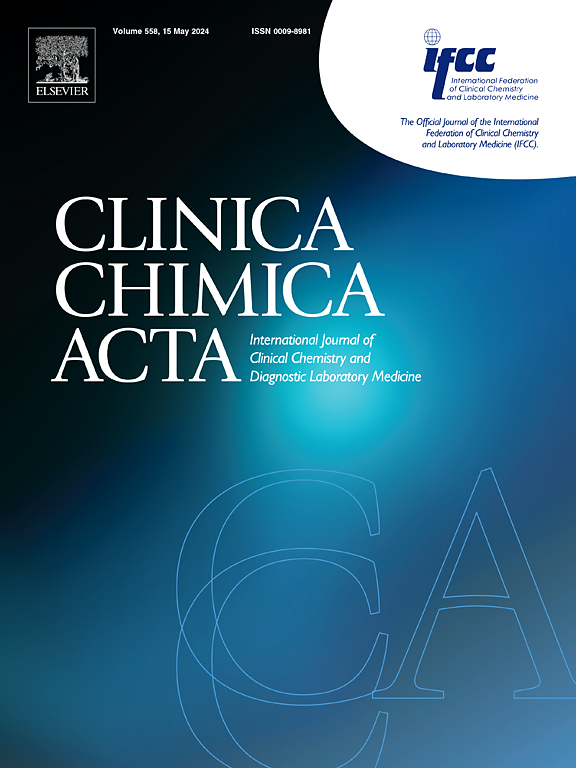Evaluation of integrated hemolysis detection by a blood gas analyzer and hemolysis effect on blood gas test results
IF 2.9
3区 医学
Q2 MEDICAL LABORATORY TECHNOLOGY
引用次数: 0
Abstract
Background
There has been a lack of effective tools to detect hemolysis in blood gas specimens. The recently launched GEM Premier 7000 with IQM3 blood gas analyzer (GEM 7000) has an integrated hemolysis detection function as part of the sample analysis workflow to flag whole blood potassium results impacted by hemolysis.
Methods
1) Hemolysis measurements were compared between GEM 7000 and Abbott Alinity c chemistry analyzer using residual heparinized whole blood specimens. 2) Hemolysis rates from GEM 7000 reported results were compared among different clinic units, and results at different hemolysis levels were compared for several analytes. 3) Hemolysis was induced in vitro by Triton X-100 treatment to examine hemolysis effect on several blood gas analytes.
Results
GEM 7000 hemolysis index results agreed with Alinity c hemolysis values in 70 out of 74 specimens, with minimal differences observed for the four discrepant samples. From Feb 2024 to Mar 2025, GEM 7000 detected hemolysis (>50 mg/dL free hemoglobin) in 8.8 % of blood gas specimens. Hemolysis rates varied from 1.5 % in the operating room setting to 18.3 % in the emergency department. Hemolyzed patient specimens showed increased median potassium results. Ionized calcium results were decreased at high hemolysis levels. No consistent changes were observed for pH, pCO2 and pO2. This was supported by the in vitro study with Triton X-100 treatment.
Conclusion
GEM 7000 allows effective detection of hemolyzed blood gas specimens. Specimens from different clinic units showed variable hemolysis rates. High hemolysis levels affect not only potassium results, but also ionized calcium.
血气分析仪综合溶血检测及溶血对血气检测结果的影响评价。
背景:在血气标本中检测溶血一直缺乏有效的工具。最近推出的带有IQM3血气分析仪的GEM Premier 7000 (GEM 7000)具有集成的溶血检测功能,作为样品分析工作流程的一部分,可标记受溶血影响的全血钾结果。方法:1)采用剩余肝素化全血标本,比较GEM 7000与Abbott Alinity c化学分析仪的溶血检测结果。2)比较GEM 7000报告结果的溶血率在不同临床单位之间的差异,并比较几种分析物在不同溶血水平下的结果。3)采用Triton X-100体外诱导溶血,观察溶血对几种血气分析物的影响。结果:在74个样本中,有70个样本的GEM 7000溶血指数结果与Alinity c溶血值一致,4个差异样本的差异极小。从2024年2月至2025年3月,GEM 7000在8. %的血气标本中检测到溶血(bbb50 mg/dL游离血红蛋白)。溶血率从手术室的1.5 %到急诊科的18.3 %不等。溶血患者标本显示中位钾升高。在高溶血水平时,离子钙结果降低。pH、pCO2和pO2没有一致的变化。Triton X-100治疗的体外研究支持了这一点。结论:GEM 7000可有效检测溶血血气标本。来自不同临床单位的标本显示不同的溶血率。高溶血水平不仅影响钾的结果,也影响离子钙。
本文章由计算机程序翻译,如有差异,请以英文原文为准。
求助全文
约1分钟内获得全文
求助全文
来源期刊

Clinica Chimica Acta
医学-医学实验技术
CiteScore
10.10
自引率
2.00%
发文量
1268
审稿时长
23 days
期刊介绍:
The Official Journal of the International Federation of Clinical Chemistry and Laboratory Medicine (IFCC)
Clinica Chimica Acta is a high-quality journal which publishes original Research Communications in the field of clinical chemistry and laboratory medicine, defined as the diagnostic application of chemistry, biochemistry, immunochemistry, biochemical aspects of hematology, toxicology, and molecular biology to the study of human disease in body fluids and cells.
The objective of the journal is to publish novel information leading to a better understanding of biological mechanisms of human diseases, their prevention, diagnosis, and patient management. Reports of an applied clinical character are also welcome. Papers concerned with normal metabolic processes or with constituents of normal cells or body fluids, such as reports of experimental or clinical studies in animals, are only considered when they are clearly and directly relevant to human disease. Evaluation of commercial products have a low priority for publication, unless they are novel or represent a technological breakthrough. Studies dealing with effects of drugs and natural products and studies dealing with the redox status in various diseases are not within the journal''s scope. Development and evaluation of novel analytical methodologies where applicable to diagnostic clinical chemistry and laboratory medicine, including point-of-care testing, and topics on laboratory management and informatics will also be considered. Studies focused on emerging diagnostic technologies and (big) data analysis procedures including digitalization, mobile Health, and artificial Intelligence applied to Laboratory Medicine are also of interest.
 求助内容:
求助内容: 应助结果提醒方式:
应助结果提醒方式:


